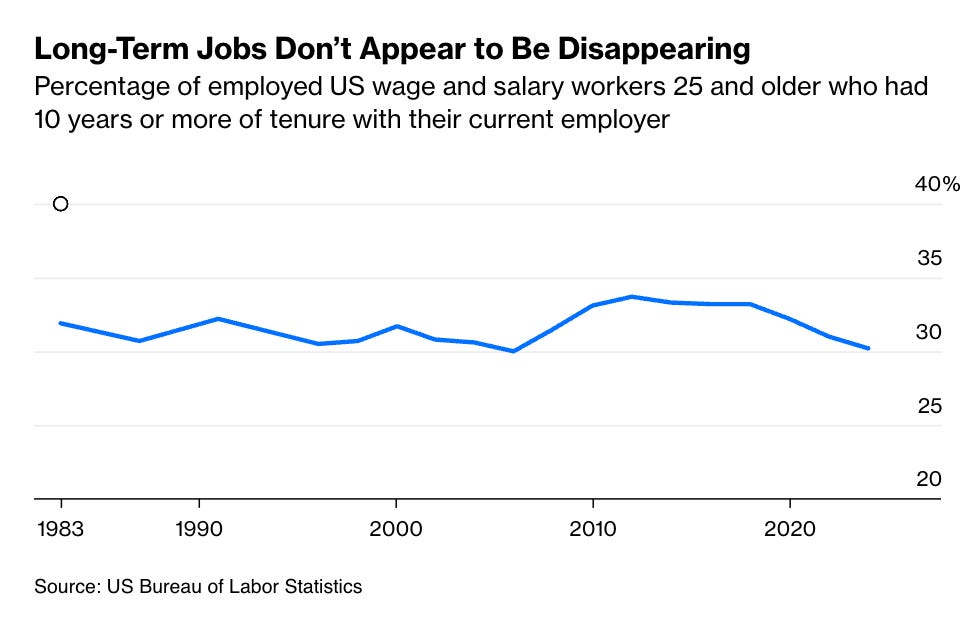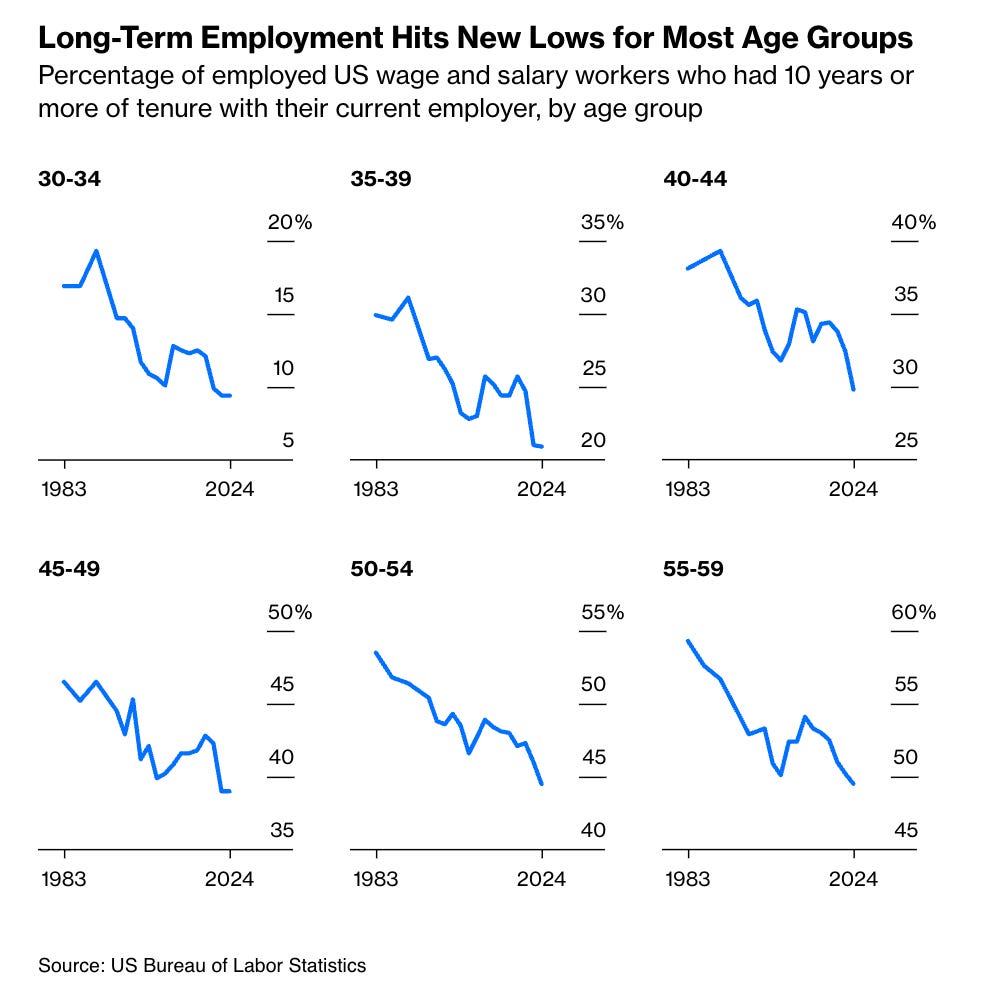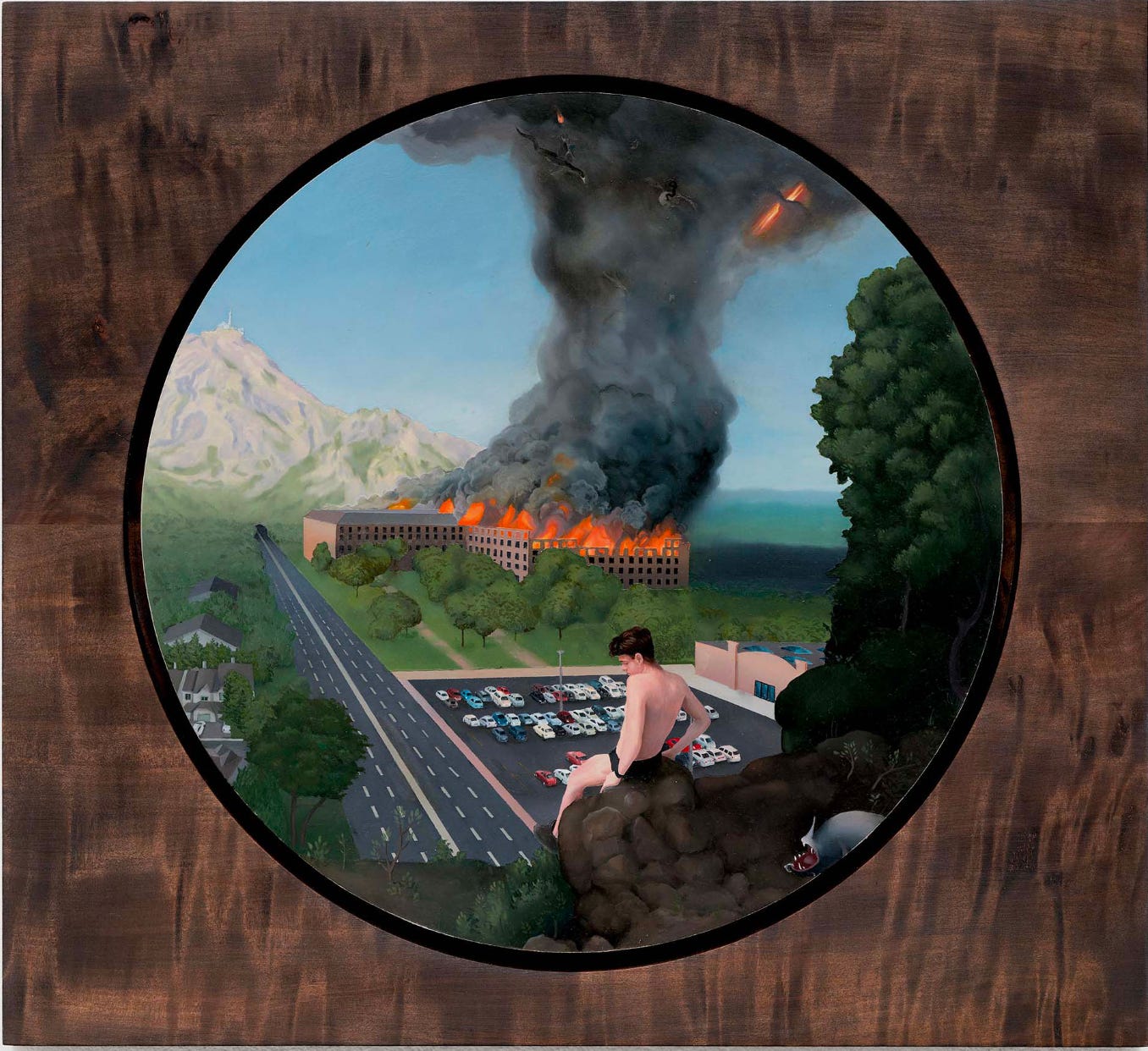Are long-term jobs disappearing? Air-conditioning's power demands. The sphere in trouble & red necks and red bandanas.
Great links, images and reading from Chartbook Newsletter by Adam Tooze
Hi, thank you for opening the Chartbook email.
"Night Club" 2022 by Jean Claracq
Are long-term jobs disappearing in the US? Justin Fox delivers a master class in composition effects.
Been with the same employer for 10 years or more? That doesn’t exactly make you a rarity in the US, where 30.2% of employed wage and salary workers were in that situation as of January 2024, according to data released last month by the Bureau of Labor Statistics. And while this percentage is down from a decade ago, it’s close to where things stood for the much of the 1980s, 1990s and 2000s. Nothing to see here, right? Contrary to oft-heard claims about the ever-more-fleeting nature of employment in the US, long-run jobs appear to be about as prevalent as ever.
Except that they aren’t, really. The placid picture painted by the above chart is the product of a so-called composition effect, in which changes in the makeup of the population being measured deliver a headline statistic that to some extent misrepresents what’s going on under the surface. In this case, the change is that the US labor force has been aging, and older workers are more likely to have been with the same employer for 10 years than younger ones. Slice up the workforce by five-year ago group, as the BLS does in the tenure statistics it releases every two years, and the percentage for every group from ages 30 to 59 turns out to have either hit a new low in 2024 or tied the low set in 2022.
So … the share of folks in long-term jobs is declining, but the share of older people is steadily increasing. And they have longer job tenure.
Source: Bloomberg
HEY READERS,
THANK YOU for opening the Chartbook email. I hope it brightens your weekend.
I enjoy putting out the newsletter, but tbh what keeps this flow going is the generosity of those readers who clicked the subscription button.
If you are a regular reader of long-form Chartbook and Chartbook Top Links, or just enthusiastic about the project, why not think about joining that group? Chip in the equivalent of one cup of coffee per month and help to keep this flow of excellent content coming.

If you are persuaded to click, please consider the annual subscription of $50. It is both better value for you and a much better deal for me, as it involves only one credit card charge. Why feed the payments companies if we don’t have to!
And when you sign up, there are no more irritating “paywalls”
Why characterizing China in terms of its foreign trade strategy is ….tendentious and why strong analogies btw last few years and early 2000s are not that helpful either.
For contributing subscribers only.
"Propaganda" by Jean Claracq, 2020
Air conditioning as a major driver of electricity demand
For contributing subscribers only.
Jimmy Dolan is finally getting credit as a visionary. The problem, however, is that artists are not always great at turning excellence into profits. Dolan, son of Cablevision founder Charles Dolan, is behind the Sphere, an orb-shaped arena in Las Vegas composed of a video screen shell. The Sphere cost $2.3bn to construct. It opened last year with an acclaimed U2 residency. But for its recently completed fiscal year, it still lost $500mn on revenue of $500mn. That is not so bad for a venue still finding its footing and that wants to establish more locations around the world. But the other half of its listed parent, Sphere Entertainment, is in trouble. Madison Square Garden Networks, the pay-TV channel that broadcasts the games of the New York Knicks and New York Rangers (separately owned by Dolan), is suffering from the ills facing traditional television networks. An $850mn loan maturity has hit this month. Sphere last week said it was negotiating with JPMorgan Chase and other lenders — whose only collateral is strictly MSG Networks, not the broader Sphere corporation — over terms of what the company described as a “workout”.
Source: Financial Times
Red Necks and Red Bandanas
The Red Necks and Red Bandanas paper is here.
A World of Public Debts … was reminded this afternoon of what a great collaboration this was.
This book analyzes public debt from a political, historical, and global perspective. It demonstrates that public debt has been a defining feature in the construction of modern states, a main driver in the history of capitalism, and a potent geopolitical force. From revolutionary crisis to empire and the rise and fall of a post-war world order, the problem of debt has never been the sole purview of closed economic circles. This book offers a key to understanding the centrality of public debt today by revealing that political problems of public debt have and will continue to need a political response. Today’s tendency to consider public debt as a source of fragility or economic inefficiency misses the fact that, since the eighteenth century, public debts and capital markets have on many occasions been used by states to enforce their sovereignty and build their institutions, especially in times of war. It is nonetheless striking to observe that certain solutions that were used in the past to smooth out public debt crises (inflation, default, cancellation, or capital controls) were left out of the political framing of the recent crisis, therefore revealing how the balance of power between bondholders, taxpayers, pensioners, and wage-earners has evolved over the past 40 years.
Source: Springer Link
"Landscape with the temptation" by Jean Claracq, 2019
If you have scrolled this far, you know you want to click:











